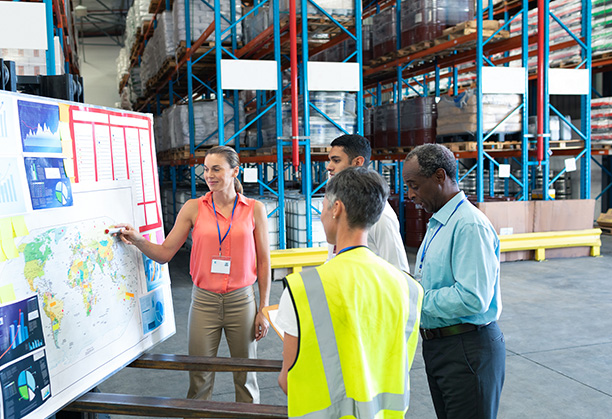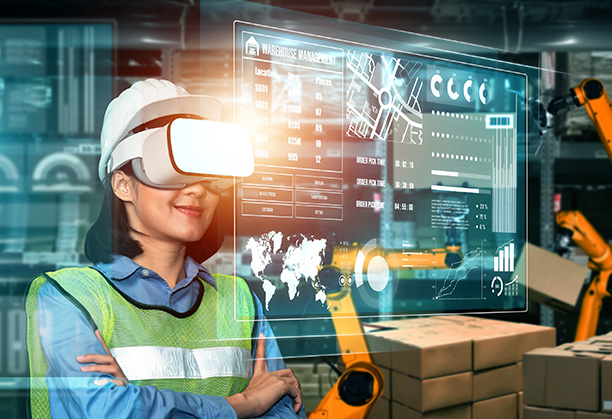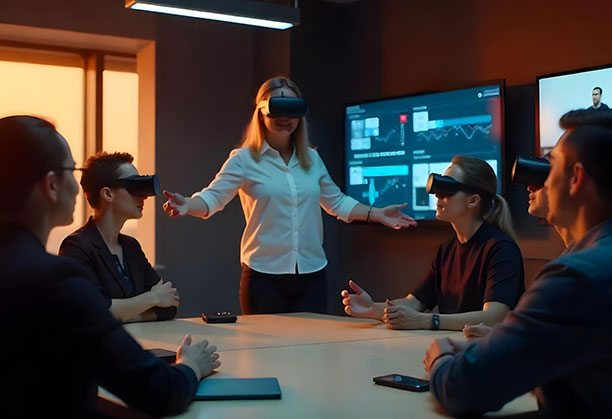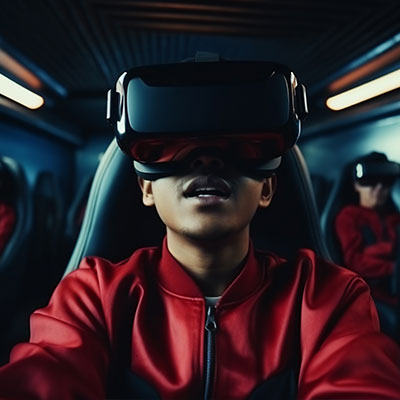The logistics and shipping industry is more crucial than ever before. Supply chain is stretching across continents, and companies now rely on sourcing and fulfillment models that prioritize speed, accuracy, and cost-efficiency. Yet, a major and persistent challenge remains: finding, training, and retaining skilled labor.
Across the supply chain, organizations are under immense pressure to hire, often including temporary staff, constantly. This is where VR in the supply chain is making a big difference. Virtual Reality enables immersive, repeatable training in risk-free environments, helping workers build competence with confidence, without disrupting actual workflows. From warehouse safety protocols to equipment handling and route planning, VR training accelerates learning, enhances engagement, and ensures consistency across teams, enabling logistics companies to scale faster and perform better in an increasingly competitive market.
Current Training Challenges in Supply Chain
Today’s supply chains are more intricate than ever before, they are a wide range of disruptions and evolving demands. To stay resilient, leaders must navigate global pressures and adopt strategies that strengthen and future-proof their operations.
Here are some key supply chain challenges that businesses face in the current environment:
1. Rapid Technological Advancements
Supply chain technologies are evolving faster than traditional training can keep up. Constant updates in tools and systems, combined with high employee turnover, make it difficult to maintain workforce competence and operational consistency across rapidly shifting tech environments.
2. Regulatory Compliance and Standards
New and evolving regulations around sustainability, human rights, and global trade compliance are difficult to track and implement. Ensuring every employee is aligned with updated policies remains a major challenge, especially in large, distributed supply chain operations.
3. Talent Retention, Engagement and Alignment
High attrition, low engagement, and outdated skills disrupt logistics workflows. Rapidly changing business needs outpace training, making it difficult to retain talent and align workforce capabilities with evolving supply chain demands.
4. Cost Management
Training large, diverse teams is expensive, especially with frequent turnover. Balancing quality learning experiences with budget constraints is a persistent challenge, often forcing businesses to compromise on depth, frequency, or reach of training programs.
5. Ensuring Accessibility and Flexibility
Global teams face barriers like time zones, language differences, and uneven access to training tools. Designing flexible, inclusive training that reaches all employees, regardless of location or schedule, remains a logistical and operational obstacle.
6. Measuring Training Effectiveness
Tracking the actual impact of training programs remains difficult. Without reliable, real-time metrics, organizations struggle to know what’s working, where employees are lagging, and how training translates into improved on-the-job performance.

Solution: Implementing VR to Overcome Challenges
Virtual Reality offers a powerful solution to talent and training challenges in logistics and shipping. Instead of temporary, inconsistent onboarding, VR delivers a standardized, immersive educational training that simulates real-world tasks, from forklift operations to route planning, without disrupting live workflows.
How it works:
- Realistic Simulations: VR modules replicate actual warehouse layouts and supply chain operations. Workers practice in dynamic, 3D environments that include equipment interaction, pallet stacking, forklift maneuvers, and even route optimization tasks.
- Repetition Without Risk: Trainees repeat procedures dozens of times-loading, scanning, driving- until they build muscle memory and confidence. Mistakes in VR carry no real-world consequences.
- Adaptive Learning Paths: Intelligent scenarios can adjust complexity: start with basic tasks, then introduce variations like time constraints, equipment malfunctions, or efficiency challenges, helping workers progress at their own pace.
Why it’s effective:
- Consistency Across Locations: Whether in India or abroad, every worker receives the same training modules, ensuring uniform quality and adherence to global compliance standards.
- Rapid Onboarding: VR reduces training time dramatically; what once took days can now be mastered in hours, allowing businesses to scale quickly for seasonal peaks.
- Continuous Skill Development: Workers revisit simulations anytime, whether desk-based or remote, supporting upskilling and retention in a sector known for high turnover.
- Data-Driven Insights: Built-in analytics track user performance, timing, errors, and efficiency, helping managers tailor follow-up training and measure ROI.
By turning abstract training into experiential learning, VR enables logistics leaders to build a confident, competent workforce, one that’s capable of meeting evolving business demands while lowering cost and risk.
How The Supply Chain Industry Uses VR: Examples
1. UPS: VR-Based Driver Training
UPS leverages VR headsets and ArborXR to immerse drivers in realistic road scenarios, pedestrians, parked cars, even animal encounters. This training cut onboarding time by 75%, from 8 hours to just 2 hours.
2. DHL: Package Handling & Route Optimization
DHL uses VR to train workers on package loading and delivery route planning. The initiative led to improved operational efficiency, lower fuel use, and reduced emissions.
3. DB Schenker: Forklift Operator Training
DB Schenker’s VR forklift simulation places operators in lifelike warehouse environments. The result: 30% reduction in training time and fewer accidents.
4. FedEx Ground: Onboarding & Safety
FedEx Ground introduced VR for new hires to practice warehouse tasks and safety procedures. Trainees gain hands-on experience before physical assignments, significantly improving retention.
5. Walmart & Amazon: Warehouse Simulation
Walmart trains employees with VR scenarios, from inventory management to emergency responses, boosting engagement by ~25% and retention by 15%. Amazon’s VR modules simulate truck loading/unloading, reducing errors and improving fulfillment efficiency.
Advantages of VR Training for the Supply Chain Industry
Virtual Reality training offers the supply chain industry with innovative solutions to simulate real-world environments and scenarios. Through immersive experiences, it enhances skill sets while ensuring safety and slashing costs.
Faster Onboarding & Skill Acquisition
VR training can dramatically accelerate learning: tasks taking 8 hours in traditional settings are mastered in just 30 minutes through VR simulations.
Enhanced Engagement & Retention
69% of organizations reported improved engagement and retention through VR training, highlighting its effectiveness in creating immersive, impactful learning experiences.
Safe, Risk-Free Practice
Trainees can repeatedly practice hazardous or complex tasks, like forklift operation or chemical spill responses, in a controlled VR environment, reducing real-world accidents.
Cost & Time Efficiency
VR eliminates the need for physical training setups, travel, or dedicated instructors, enabling scalable and cost-effective training across locations.
Operational Precision & Error Reduction
VR logistics training reduces inventory handling errors by 15% and enhances workplace efficiency by 20%, making operations faster, safer, and smarter.
Consistency Across Global Teams
Virtual simulations ensure standardized training experiences for employees worldwide, bridging geographical barriers and ensuring uniform competency.

Future Trends in Supply Chain Training with VR
Personalized, AI-Driven Training Paths
VR training platforms are increasingly integrating artificial intelligence to analyze employee performance in real time and adapt scenarios to individual learning needs. This creates personalized learning journeys, ensuring each worker masters skills at their own pace while receiving instant feedback for improvement.
Immersive Soft Skills and Leadership Development
Beyond technical operations, VR is being used for scenario-based soft skills training, such as team management, negotiation, and conflict resolution, by simulating realistic workplace interactions. This approach helps build leadership and communication skills essential for modern supply chain roles.
Integration with the Metaverse and Digital Twins
Supply chain training is moving toward fully immersive, collaborative environments where employees can interact with virtual warehouses, digital twins of equipment, and remote colleagues. These metaverse-inspired platforms enable real-time problem-solving, process optimization, and cross-location teamwork without physical presence.
On-Demand, Scalable, and Cost-Effective Learning
VR enables companies to deliver standardized training across global locations, eliminating travel and material costs. Employees can access modules anytime, allowing for rapid onboarding, upskilling, and seasonal workforce scaling with consistent quality.
Enhanced Analytics and Predictive Insights
The future of VR training includes robust analytics dashboards that track user progress, assess skill gaps, and predict workforce readiness. These insights help organizations optimize training investments, allocate resources efficiently, and proactively address operational challenges.
Ready for risk-free supply chain training?
Juego neXR: Reshaping Supply Chain Efficiency Through VR Training
At Juego neXR, we design immersive Virtual Reality training experiences built specifically for the modern supply chain. From warehouse operations to last-mile logistics, our VR solutions replicate high-pressure, real-world scenarios, enabling employees to learn safely, quickly, and repeatedly without disrupting active workflows.
Whether it’s route optimization, forklift operation, or safety protocol, our simulations foster faster onboarding, improved retention, and operational precision. With scalable modules and real-time performance analytics, Juego neXR empowers supply chain leaders to close skill gaps, cut training time, and standardize performance across global teams.
As logistics becomes more complex, our high-fidelity VR environments future-proof workforce training, driving efficiency, safety, and resilience at scale.
Conclusion
Virtual Reality is emerging as a powerful force reshaping how supply chain teams are trained and retained. From global giants like UPS and DHL to rapidly scaling e-commerce businesses, VR is helping companies overcome talent shortages, reduce training time, and enhance operational consistency across locations. Despite challenges like high initial investment and content complexity, the benefits, faster onboarding, improved safety, higher retention, and cost savings, far outweigh the barriers.
As VR continues to evolve with AI-driven personalization, metaverse integration, and predictive analytics, its role in supply chain training will only grow more essential. Organizations that invest in immersive, scalable VR solutions today are not just solving current workforce issues; they’re building smarter, more resilient operations for the future. For businesses looking to train faster, safer, and smarter, VR is no longer optional; it’s transformative.
Frequently Asked Questions
Companies often struggle with high initial setup costs, lack of internal expertise, and resistance to change from traditional training teams. Integrating VR also requires aligning new content with existing learning objectives, ensuring hardware compatibility, and maintaining data privacy. Additionally, scalability across locations and measuring ROI effectively can be complex. Without strategic planning and the right partners, VR adoption risks becoming a siloed or underused tool rather than a seamless extension of existing training programs.
VR simulation can absolutely be customized for specific supply chain processes. Modern VR training solutions are built with modular design, allowing companies to replicate their unique warehouse layouts, machinery, workflows, and safety protocols. Whether it’s simulating forklift navigation in tight aisles, packaging procedures, or emergency response drills, the scenarios can mirror real-world operations. This level of customization ensures that training is directly relevant, practical, and aligned with company-specific SOPs, far more effective than one-size-fits-all, generic simulations.
Supply chain VR training programs typically use high-quality VR headsets like Meta Quest, HTC Vive, or Pico for immersive experiences. These are paired with motion controllers and, in some cases, haptic gloves for interactive feedback. On the software side, platforms like Unity or Unreal Engine are commonly used to develop custom training simulations. Enterprise VR management tools such as ArborXR or Strivr help deploy, monitor, and update training modules across locations, ensuring consistency, scalability, and seamless integration with existing Learning Management Systems (LMS).
Data collected during VR training sessions on cloud-based platforms is typically secured using encryption protocols, user authentication, and role-based access controls. Reputable VR solutions also comply with global data protection regulations like GDPR and SOC 2. Regular audits, secure APIs, and end-to-end encryption help prevent unauthorized access. However, the level of security ultimately depends on the provider’s infrastructure, making it crucial to choose a trusted vendor with transparent data policies and a proven track record in cybersecurity.
Revolutionize the future of business with Juego neXR
Table of Contents
- Current Training Challenges in Supply Chain
- Solution: Implementing VR to Overcome Challenges
- How The Supply Chain Industry Uses VR: Examples
- Advantages of VR Training for the Supply Chain Industry
- Future Trends in Supply Chain Training with VR
- Juego neXR: Reshaping Supply Chain Efficiency Through VR Training
- Conclusion
- Frequently Asked Questions
Related Posts
Share this Article:
Our Offices

India
Bangalore
GR Grand Plaza, 2nd Floor, JP Nagar, 6th Phase, Bangalore – 560 078

KSA
Jeddah
St Idris Square, 4036 Helmi Koutbi, Al Zahra, Jeddah 23425, Saudi Arabia
Follow Us On:
© 2025 Juego neXR. All Rights Reserved.



